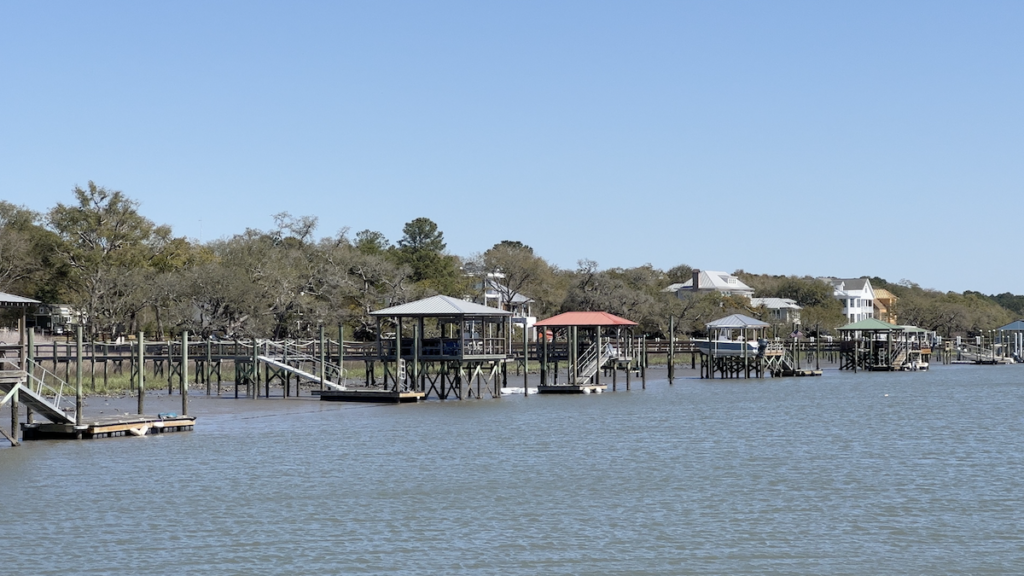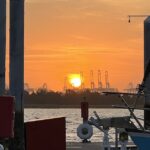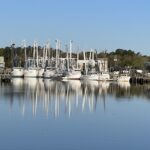We finally get on our way with a leisurely 36-mile cruise up the ICW.
I woke early — at least two hours before dawn — after the best night’s sleep I’d had so far on the trip. I made my coffee, remembering to heat the mug in the microwave, and settled down at the table with my laptop to write up my blog post about our shore days in Charleston. And that’s where Capt John found me a while later when he came out of his cabin.
We had breakfast. I tried the “3-minute” steel cut oatmeal that had been on board when we arrived. I’d always wanted to try the stuff and I’m glad I got it done without actually buying it. It took a lot longer than 3 minutes and wasn’t very good. Cross that off future shopping lists.
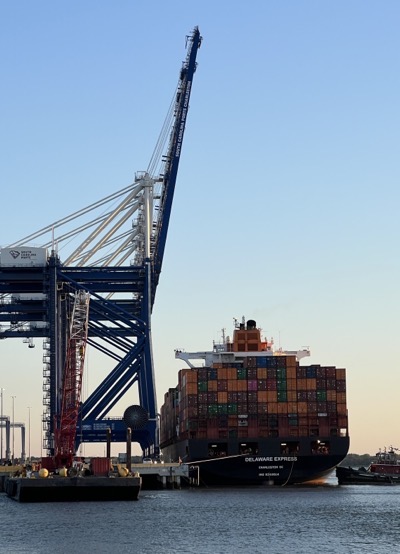
It wasn’t until the morning of our departure that a container ship finally arrived at the terminal across the inlet from us. If it had arrived the previous day, I would have set up a time-lapse to record the unloading.
The sun rose while we were having breakfast. I cleaned up a little, followed John up to the main building for a last bathroom stop, and walked back to the boat alone, taking a few last photos of the area along the way.
Casting Off
While I waited for John, I figured I’d get started on the process of disconnecting from shore. I disconnected the hose but had a lot of trouble neatly coiling it in the cool morning air. I figured I’d have a better chance at doing a neat job after the sun had warmed it for a while. I also unfastened and coiled the extra line we’d run from the boat to a cleat on our neighbor’s side of the dock.
By that time, John was back. I followed his instructions to remove or secure a few other lines and helped him with the two 30 amp power cords. (A boat this size is a thirsty puppy for fuel and electricity.) Then he climbed up to the command bridge and started the two engines, one at a time. They came to life immediately, growling roughly a little at first but then settling in smoothly.
By this time, another boater was standing by to help with the lines. I had mixed feelings about this. First, I always appreciate help when it’s good, experienced and knowledgeable help. This guy was from one of the other big boats so I assumed he knew what he was doing. So did John. But when John started giving him cast off instructions instead of me, I felt a little worried that he didn’t trust me to do the task. What would happen when we needed to cast off and there wasn’t any help? I guess we’d find out eventually.
I followed John’s instructions to climb aboard while he held the stern line back on the boat. Then he climbed back up to the bridge while our helper on the dock finished casting us off. John backed out of the slip, made a 180° turn, taking full advantage of the two engines, and pointed us away from the marina. I walked around the gunwales and pulled in all of the fenders, lying them down on the deck as I’d been instructed to. With all the entrances to the gunwales closed up and all the lines secured, I climbed up to the bridge.
We were finally under way.

Capt John at the helm as we departed Charleston, SC on Saturday morning. The command bridge has an awesome view of the area from about 10 feet above the water line.
Charleston Harbor
Our course took us down the Cooper River — the marina wasn’t far from its confluence with the Wando River — under the Arthur Ravenel Jr Bridge (where US 17 crosses the harbor), and out into a relatively wide harbor dotted with small islands. From there, we really relied on the GPS and numbered markers to find the narrow and almost hidden entrance to the Intracoastal Waterway (ICW).

The dashed magenta line marks our actual course through Charleston Harbor from the marina. This is a vector chart as it appears on the Aqua Map iOS app.
I was surprised to see an aircraft carrier parked near the east side of the bridge. It’s the decommissioned USS Yorktown, on display with a WWII destroyer, USS Laffey, at the Patriots Point Naval & Maritime Museum.

If you look carefully on the left side of this bridge, you should be able to see the aircraft carrier parked there.
Two highlights in the harbor: two dredging operations — one active and one at a stop — and a dolphin or porpoise jumping out of the water in front of the boat. I didn’t have any of my GoPros set up so I missed getting a photo of the dolphin. It was still pretty cool to see; Capt John later saw another one in the ICW.
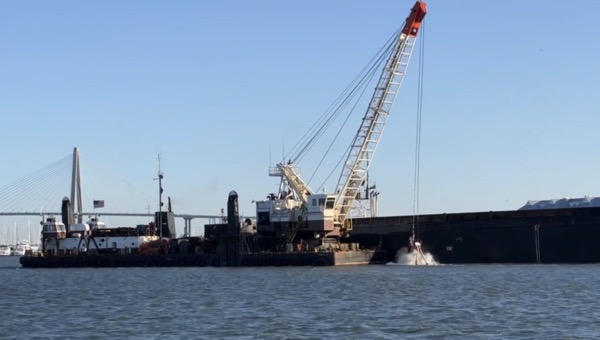
An active dredging operation in Charleston Harbor. I have a video clip of this and will likely include it in any video I make of our first day on the water.
Under Way

We wound up following this sailboat for most of the day; I shot this photo just before we made our turn to our destination.
The water was relatively calm with a tiny chop on the surface but no swells at all. It was a smooth ride. Capt John did the driving while I sat up top with him — heck, there’s enough seating up there for at least six people — and watched for markers, crab pot buoys, and other traffic. That last category was the emptiest; although we passed communities, a few marinas (in Charleston and later Isle of Palms), and many homes with long walkways out to their private docks, there weren’t many boats out on the water. We found ourselves following a sailboat with a single sail up for the entire drive and caught up to him (but didn’t bother passing) right before we reached our destination.

There were some very large boats at the Isle of Palms Marina not far from Charleston Harbor.

Of importance to tall boats: the clearance between the bottom of a bridge and the water line. Most bridges had signs like this that give an accurate reading based on the tide and water height.
Our pace was slow. Carver 36 has two gasoline engines and they are thirsty. Capt John choose his cruise speed based on RPMs that would give him an acceptable fuel economy. Acceptable, but never really good. We were going to burn fuel one way or the other, but John liked to take his time cruising. So he set his RPMs for about 6-8 knots of speed. With a tailwind that morning but slowing down to No Wake speed as we passed marinas and occupied docks, we averaged just 6.5 knots for the day. I have to say that I was a little disappointed by that; I was hoping to average at least 8 knots. But did it really matter? I did want to see what we were cruising through and I needed a minimum of 4 hours per day to be able to log it.
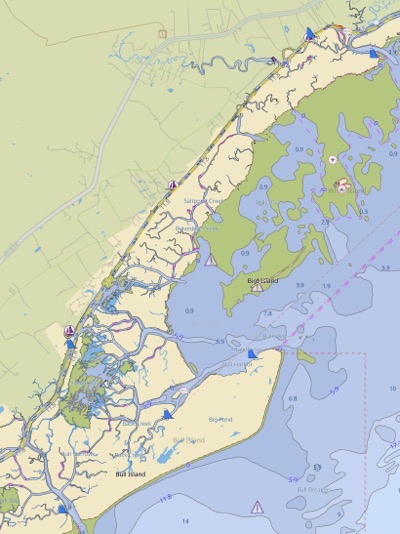
Here’s a segment of our route (the yellow dashed line) that shows a big picture of the area. The mainland is on the left and has creeks and rivers flowing into the ICW. The barrier islands and marshes are on the right and have lots of little channels, some of which go out to the Atlantic Ocean.
The areas we passed through were mostly dredged canals or existing waterways. There was always marshland or barrier islands on the starboard (right or east) side of us as we headed northwest up the coast. That kept the water calm, despite the ever increasing wind from behind. We were traveling at mostly low tide, although it was coming in as we traveled. That probably gave us a little current boost, at least part of the time.
You see, the channel we were in had lots of little channels off to one side or the other. Channels on the port side were usually creeks, rivers, or just marshland channels. Channels from the starboard side often led out to sea and became the pathways for the tidal flows. As a result of all this, the water was generally calm but had a current and the current depended on the tides.
This is something that I didn’t really experience on my Great Loop 2021 trip, which had started at New York Harbor and quickly left tidal waters as we motored up the Hudson, continuing in fresh, non-tidal water through the Erie Canal and two of the Great Lakes. This was the new experience that I was looking for on this trip. How would the tides and related currents affect navigation and boat handling? Over the next five weeks, I hoped to find out.
As far as scenery is concerned, after the waterfront communities on the way out of the Charleston area, the areas on both sides of the ICW were sparsely populated. There were occasional communities with private docks, most of which seemed deserted on this late March Saturday. There was a park with a boat ramp and campsites that seemed pretty active. Otherwise, it was mostly marshland with clumps of tall trees or southeast style dense forest on shore. I didn’t note any interesting wildlife other than a some sea birds. I suspect the wading birds were mostly out in the marsh.
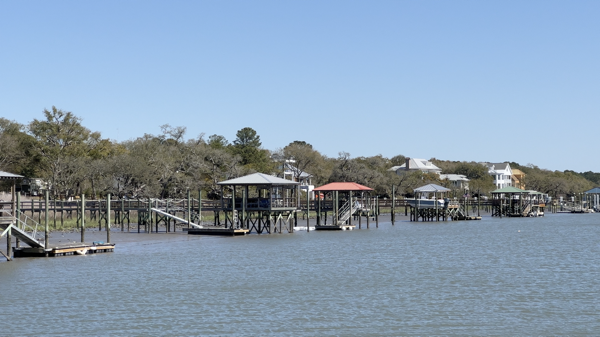
In some areas, there were long lines of waterfront homes, each with its own private dock or boat lift.

This lonely house out on the marsh is something I’d like very much — until a hurricane blew in.
We had one tricky navigational challenge just past Isle of Palms. It was a huge dredging operation that included several barges and tugboats, including a barge that looked like it was designed to house workers. It was positioned in the middle of the channel leaving us a choice to go around it on one side or the other. Capt John chose to go around on the west side (our port), putting the operation to the east (starboard) side of us. He took it slow with his eyes moving from the dredging boats to Carver 36’s depth readings. It was nearly low tide, after all. The depth got down to about 5 feet in a few spots. Carver 36 needs about 3 1/2 feet of water to keep from running aground, so it was pretty close. It was good to emerge on the other end without any problems.

Here’s the dredging operation we passed at MM 456 on the ICW. In hindsight, I think we would have had deeper water on the other side.
Arriving at McClellanville
It was nearly 1:30 PM when we arrived at the mouth of Jeremy Creek. Capt John called the marina and learned about the dock and which side of the boat we’d be tying up at. I got to work, walking out on the gunwales to drop the fenders on the starboard side.
The wind was blowing hard and pushed us into the dock, but the woman who’d come out to meet us, Lacey, grabbed the line I tossed her and we settled the boat against the dock without any problems. Capt John came down and together we positioned and tightened the four lines. We’d been parked in front of a similar boat that also flew a Looper flag.
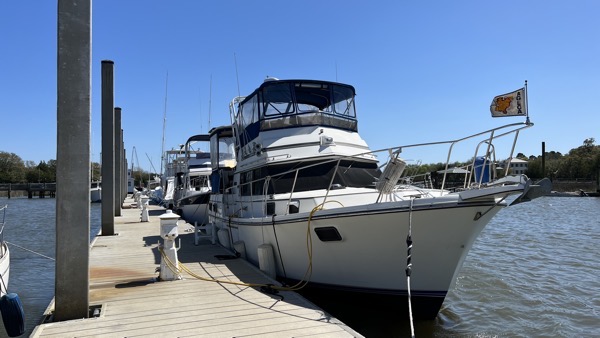
Here’s Carver 36 docked at McClellanville.

McClellanville’s harbor was choppy, with the water whipped up by high winds.
We checked in at the fuel shack and were told where to find the bathroom and free laundry facility. Then Lacey drew a map on John’s receipt that included a seafood market, an Episcopal church with nice stained glass windows, a 1000 year old tree, and a restaurant, all within walking distance.
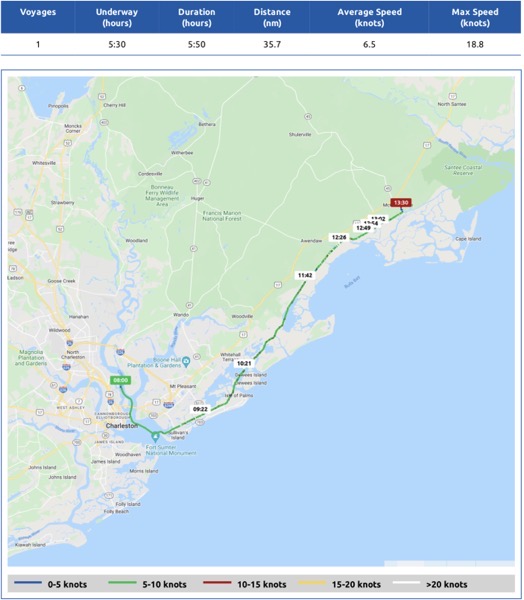
Here’s my Nebo log for Day 5 of my trip.
We went back to the boat, had lunch, and then started off for a walk.
In McClellanville
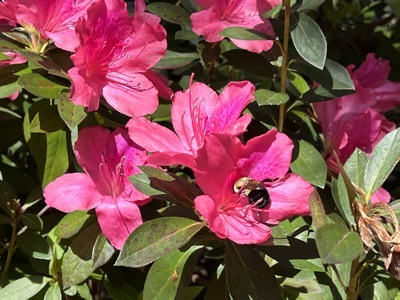
There were lots of azalea bushes around town.
The town was small but very pleasant with shady tree-lined streets and friendly people. We followed the map Lacey had given us, visiting each point of interest.
St. James-Santee Parish Episcopal Church, which was established in 1687, is currently in a building erected in 1890. It’s a very small chapel, with pretty stained glass windows behind the altar.
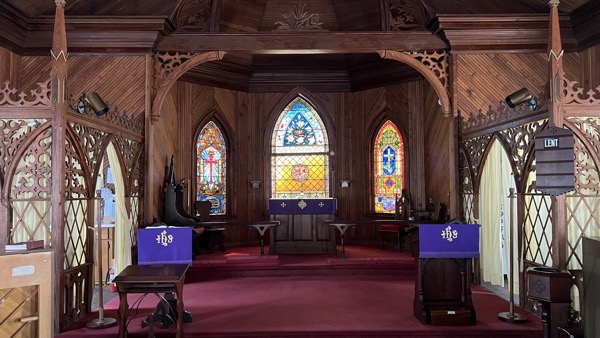
Inside the Episcopal Church.
The tree was only about a block away. It was predictably huge with giant branches that fanned out over the area. A swing hung from one branch and kids were playing on it. I later learned that it has a name — the Deerhead Oak because you supposedly can see a deer’s head with antlers when you look at it — and a bunch of articles on the Internet, like this one, about it. We chatted with the mom who was with them. She told us we’d just missed the Wisteria Parade earlier that day and showed us photos on her phone of kids dressed up with flowers.
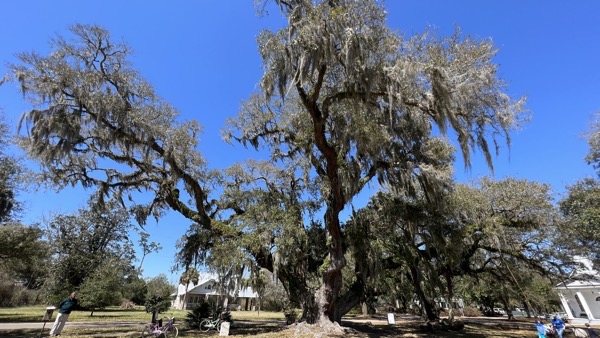
I don’t see a deer head here, but I don’t need to. There’s some distortion in the photo because of the wide angle lens I used to shoot it.
We continued on to town. There was a local art gallery that we visited briefly; it had a needlework exhibit of new and old work. Town was tiny. The restaurant was closed. We took another street back to the harbor area, stopping at the fish market. There wasn’t much to choose from. John bought a pound of local shrimp for dinner; because shrimp season didn’t start until May, however, they’d been caught, frozen, and then thawed.
Day’s End
We took it easy back at the boat. I finished and published the blog post for days 2 through 4 of the trip. Afterwards, we opened a bottle of wine and swapped stories while John cleaned all those shrimp. I whipped up a dinner of aromatic vegetables — that’s carrots, celery, and onions — with potatoes and those shrimp. It came out good, if I do say so myself.
By 8 PM, we went our separate ways. I did some reading in my cabin before falling asleep.
